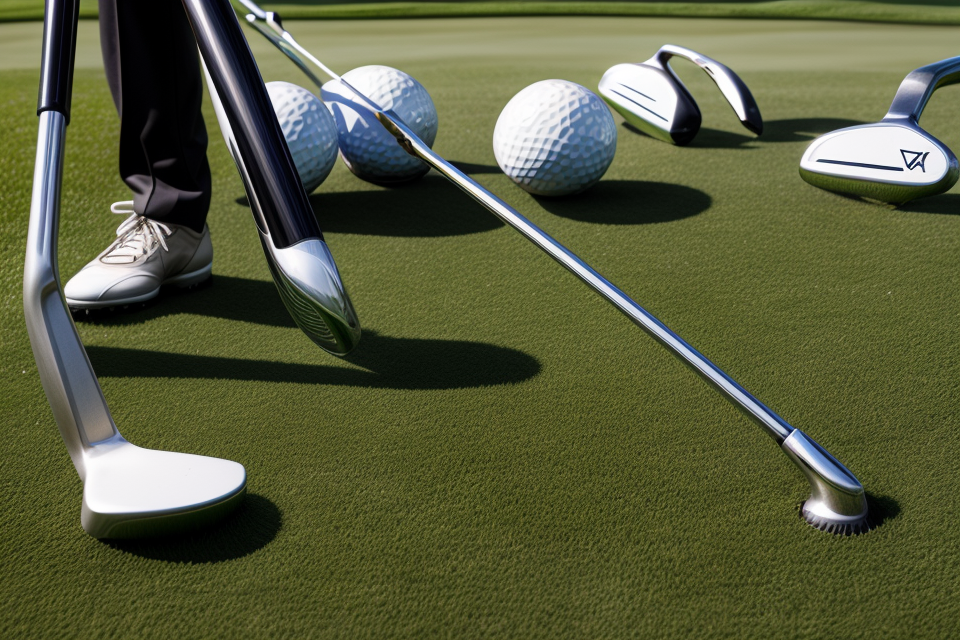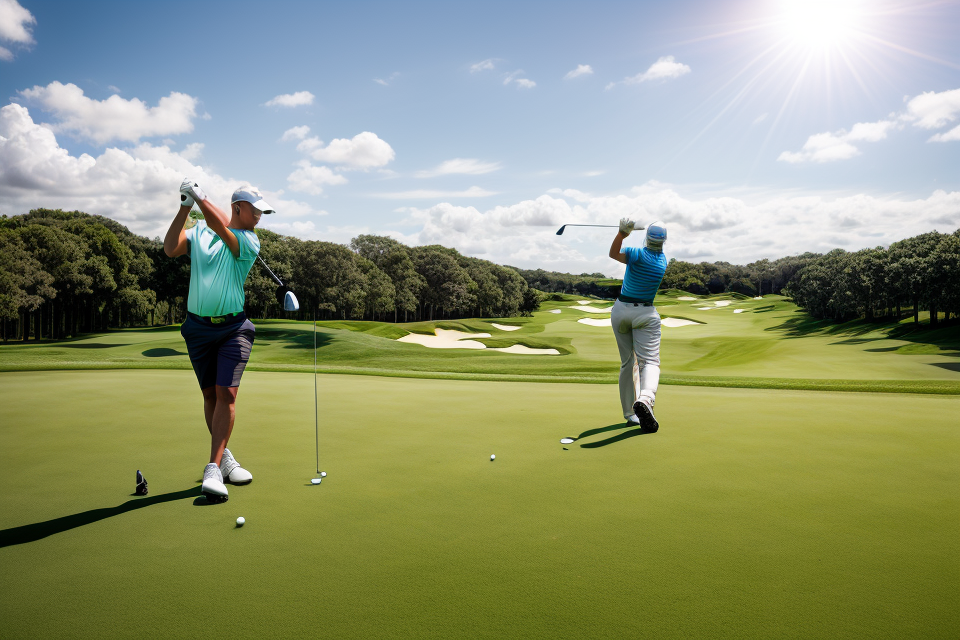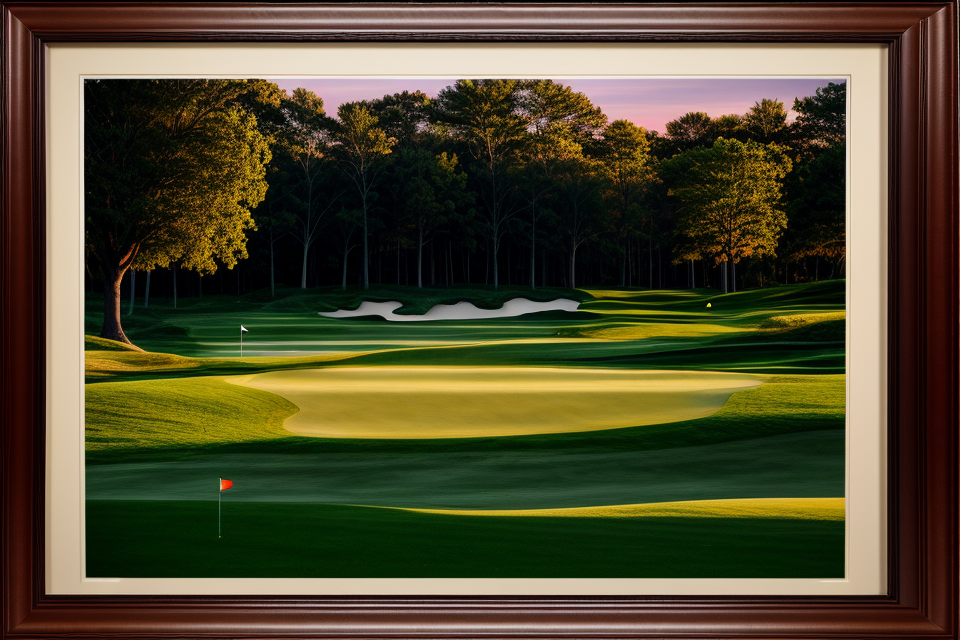
Golf clubs are an essential part of the game, and each club has a unique set of numbers that distinguish it from the rest. But what do these numbers mean? If you’re a beginner golfer, understanding the meaning of golf club numbers can be confusing. In this comprehensive guide, we’ll demystify the world of golf club numbers and provide you with a clear understanding of what they represent. From the loft of the club to the shaft flex, we’ll cover it all. So, get ready to take your golf game to the next level with this in-depth look at golf club numbers.
Golf Club Anatomy
Golf Club Length
When it comes to golf clubs, length is an important factor to consider. The length of a golf club can affect the player’s swing, ball speed, and overall performance. Here are some details on the different lengths of golf clubs:
Standard Length
Standard length golf clubs are the most commonly used by golfers. These clubs are designed to fit the average golfer and provide a balanced and comfortable grip. Standard length clubs are typically 35-37 inches in length for men and 34-36 inches for women.
Plus/Tour Length
Plus or Tour length golf clubs are designed for golfers with faster swing speeds or those who prefer a longer club for more control over their shots. These clubs are typically 1-2 inches longer than standard length clubs, making them ideal for golfers who want to hit the ball further or those who have a very fast swing speed.
Junior Length
Junior length golf clubs are designed for younger golfers or those with smaller statures. These clubs are typically 1-2 inches shorter than standard length clubs, making them easier for younger golfers to handle and control. Junior clubs are available in a variety of sizes to fit different age groups and heights.
Overall, the length of a golf club is an important factor to consider when choosing the right club for your game. It’s important to choose a club that fits your body type and swing style, as well as your skill level, to ensure the best possible performance on the course.
Golf Club Loft
When it comes to golf clubs, loft refers to the angle between the clubhead and the shaft when the club is in a vertical position. This angle affects the trajectory and distance of the ball when it is struck. In general, a higher loft angle will result in a higher trajectory and shorter distance, while a lower loft angle will result in a lower trajectory and longer distance.
Low Loft
Low loft golf clubs have an angle of less than 10 degrees. These clubs are typically used for full shots, such as drives and fairway woods, as they provide a low trajectory and long distance. They are also used for shorter approach shots where a higher trajectory is not necessary. Examples of low loft golf clubs include the 1 wood, 3 wood, and 5 wood.
Mid Loft
Mid loft golf clubs have an angle between 10 and 14 degrees. These clubs are used for a variety of shots, including approach shots, pitches, and chips. They provide a higher trajectory than low loft clubs, but still produce a relatively straight shot. Examples of mid loft golf clubs include the 2 iron, 4 iron, 6 iron, 8 iron, and 9 iron.
High Loft
High loft golf clubs have an angle of more than 14 degrees. These clubs are used for shorter shots, such as pitches, chips, and bunker shots. They produce a high trajectory and stop quickly on the green, making them ideal for accurate approach shots and delicate greenside shots. Examples of high loft golf clubs include the sand wedge, lob wedge, and approach wedge.
Golf Club Flex
Golf club flex refers to the amount of bending or torque that a golf shaft can undergo during a swing. It is an essential aspect of golf club design as it affects the club’s performance and the player’s ability to control the ball. The three primary types of golf club flex are regular flex, stiff flex, and senior flex.
Regular Flex
Regular flex is the most common type of golf club flex, suitable for a wide range of golfers, including high-handicappers and beginners. This flex provides a balanced combination of control and feel, allowing players to generate sufficient power while maintaining accuracy. Regular flex shafts are designed to bend moderately during the swing, providing a smooth transition from the golfer’s body to the clubhead.
Stiff Flex
Stiff flex shafts are designed for more experienced golfers with faster swing speeds and higher clubhead velocities. These shafts are less flexible than regular flex shafts, allowing players to generate more power and control through the swing. Stiff flex shafts are particularly beneficial for players who tend to slice the ball or hit it too high, as they help to reduce spin and maintain a lower, more penetrating ball flight.
Senior Flex
Senior flex shafts are designed for golfers with slower swing speeds and older players who may experience reduced power and control as they age. These shafts are the most flexible of the three types, allowing players to generate more power and maintain accuracy without sacrificing feel. Senior flex shafts are ideal for players who struggle to generate sufficient clubhead speed to reach their optimal ball flight and distance.
Understanding golf club flex is crucial when selecting the right equipment for your game. By considering your swing speed, skill level, and playing style, you can choose the flex that best suits your needs and helps you achieve your desired results on the course.
Golf Club Numbers Explained
The Meaning of Golf Club Numbers
Standardization
Golf club numbers refer to the numerical rating assigned to each golf club to indicate its relative loft, or the angle at which the club face is tilted in relation to the ground. The standardization of golf club numbers ensures that golfers can compare clubs from different manufacturers and easily understand the loft and overall performance of each club. This standardization allows golfers to make informed decisions when selecting clubs for their bag and to optimize their game.
Customization
In addition to standardization, golf club numbers also allow for customization based on individual golfer preferences. Golfers can choose clubs with different lofts and numbers to suit their personal playing style, swing speed, and ball flight. This customization allows golfers to fine-tune their game and achieve optimal performance on the course. By selecting clubs with specific lofts and numbers, golfers can control ball trajectory, spin, and distance, allowing them to adapt to different playing conditions and course layouts.
In summary, golf club numbers play a crucial role in providing a standardized way to compare clubs and also offer the flexibility for customization based on individual golfer preferences. By understanding the meaning of golf club numbers, golfers can make informed decisions when selecting clubs and optimize their game to achieve better performance on the course.
Golf Club Numbering System
Golf club numbers refer to the measurement of the loft and length of golf clubs. The numbering system used for golf clubs is a standardized method developed by the United States Golf Association (USGA) to provide golfers with a uniform way of comparing clubs.
The golf club numbering system consists of two digits separated by a hyphen. The first digit represents the loft of the club, while the second digit represents the length of the club.
The loft of a golf club refers to the angle between the club’s shaft and the ground when it is in a position to strike a ball. A higher loft angle indicates that the ball will be launched at a higher trajectory, while a lower loft angle indicates that the ball will be launched at a lower trajectory.
The length of a golf club refers to the distance from the tip of the club’s shaft to the ground when it is in a position to strike a ball. Longer clubs typically have a higher loft angle, while shorter clubs typically have a lower loft angle.
The golf club numbering system provides a simple and consistent way for golfers to compare clubs based on their loft and length. By understanding the meaning of golf club numbers, golfers can make informed decisions when selecting clubs for their golf bag, ensuring that they have the right clubs for their game and playing conditions.
Golf Club Numbering System: A Closer Look
Understanding Golf Club Loft
Golf club loft refers to the angle between the shaft of the club and the ground when the club is in a position to strike a ball. This angle, measured in degrees, has a direct impact on the trajectory and distance of the shot. Understanding golf club loft is crucial for golfers as it helps them select the appropriate club for different shots and playing conditions.
Degrees of Loft
The loft of a golf club is measured in degrees, with lower numbers indicating a lower loft and higher numbers indicating a higher loft. Generally, the loft of a golf club ranges from 8 degrees to 16 degrees for drivers, 16 degrees to 24 degrees for fairway woods, 24 degrees to 32 degrees for hybrids, and 32 degrees to 48 degrees for iron clubs.
Types of Golf Clubs by Loft
There are several types of golf clubs with different lofts, each designed for specific purposes:
- Drivers: Typically have a loft of 8-10 degrees and are used for tee shots and long drives.
- Fairway Woods: Have a loft of 13-16 degrees and are used for medium-distance shots and approach shots.
- Hybrids: Have a loft of 16-24 degrees and are a combination of wood and iron clubs, designed to replace long irons in a golfer’s bag.
- Irons: Have a loft of 24-48 degrees and are used for shorter-distance shots and approach shots around the green.
- Wedges: Have a loft of 48-64 degrees and are used for high-loft shots around the green, such as pitches, chips, and bunker shots.
Understanding the different lofts of golf clubs and their corresponding purposes can help golfers select the right club for each shot, leading to improved accuracy and distance control.
Decoding Golf Club Length
Golf club length is a crucial factor in determining the overall performance of a golfer’s shot. Understanding the significance of golf club numbers and lengths can help golfers make informed decisions when selecting the right equipment for their game. In this section, we will delve deeper into the process of decoding golf club length, exploring the units of measurement used, and the factors that can affect the length of a golf club.
- Inches and Centimeters:
Golf club lengths are typically measured in both inches and centimeters. The standard measurement for golf clubs is in inches, with most clubs ranging from 33 to 46 inches in length. However, many manufacturers also provide measurements in centimeters for added convenience. To convert inches to centimeters, golfers can use the simple conversion formula of multiplying the inches by 2.54.
- Factors Affecting Golf Club Length:
Several factors can influence the length of a golf club, including the golfer’s physical attributes, swing style, and playing preferences. Here are some of the key factors that can affect golf club length:
+ Golfer’s Height and Arm Length:
Shorter golfers may benefit from using shorter clubs, as longer clubs can be more difficult to control. Conversely, taller golfers may require longer clubs to generate sufficient power and distance.
+ **Swing Style:**
Different swing styles can also impact the ideal length of a golf club. For example, golfers with a more conventional, upright swing may benefit from using clubs with slightly shorter shafts, while golfers with a more flat or bent-over swing may prefer longer clubs.
+ **Playing Preferences:**
Golfers may also have personal preferences when it comes to club length. Some players may prefer a specific length based on their experience or feel more comfortable with a certain club length.
+ **Course Conditions:**
The course conditions can also play a role in determining the ideal club length. For example, golfers may opt for shorter clubs in wet or muddy conditions to maintain control, while longer clubs may be preferred on dry, firm courses to generate more distance.
By understanding the factors that affect golf club length, golfers can make more informed decisions when selecting equipment that best suits their game.
Deciphering Golf Club Flex
Golf club flex refers to the stiffness of the shaft in a golf club. The flex of a golf club is determined by the material, design, and size of the shaft. Golf club flex is categorized into several types, which are typically identified by letters ranging from A to L. Each letter represents a different level of flex, with A being the stiffest and L being the most flexible.
The flex of a golf club is important because it affects the player’s ability to control the ball’s trajectory and distance. A player with a higher handicap may benefit from a more flexible shaft, as it allows for greater control over the ball. Conversely, a player with a lower handicap may prefer a stiffer shaft, as it provides more stability and accuracy during the swing.
The following table outlines the different golf club flex categories and their corresponding letters:
| Letter | Flex | Player Type |
|---|---|---|
| A | Very Stiff | Low Handicap |
| R | Stiff | Low to Mid Handicap |
| S | Regular | Mid Handicap |
| A | Regular | Mid to High Handicap |
| L | Very Flexible | High Handicap |
When choosing a golf club, it is important to select a flex that matches your skill level and playing style. A golfer with a higher handicap may benefit from a more flexible shaft, while a golfer with a lower handicap may prefer a stiffer shaft. The right flex can make a significant difference in the accuracy and distance of your shots.
The Significance of Golf Club Numbers for Beginners
As a beginner, understanding the significance of golf club numbers can greatly aid in selecting the right golf clubs and customizing them to your specific needs. Here are some key points to consider:
Selecting the Right Golf Clubs
One of the most important factors in selecting the right golf clubs is understanding the different golf club numbers and their corresponding lofts. Golf club loft refers to the angle of the clubface relative to the ground, which affects the trajectory and distance of the shot.
For example, a lower lofted club such as a 3 wood will produce a lower, straighter shot, while a higher lofted club such as a 9 iron will produce a higher, more controlled shot with less distance. Knowing the appropriate golf club numbers for your skill level and playing style can help you select the right clubs for your game.
Customizing Golf Clubs
In addition to selecting the right golf clubs, understanding golf club numbers can also aid in customizing your clubs to your specific needs. For example, many golfers choose to add a weight to the head of their driver to increase the clubhead speed and distance. However, this can also affect the ball flight and spin, so it’s important to know the corresponding golf club numbers and how they will affect your game.
Furthermore, understanding the golf club numbers can also help you determine the appropriate shaft flex and weight for your clubs. A stiffer shaft may be appropriate for a more experienced golfer, while a softer shaft may be better for a beginner or someone with a slower swing speed.
Overall, knowing the significance of golf club numbers as a beginner can greatly aid in selecting and customizing the right golf clubs for your game.
FAQs
1. What are golf club numbers?
Golf club numbers refer to the loft of a golf club, which is the angle between the clubface and the ground when the club is in a normal address position. The lower the number, the less loft the club has, and the farther the ball will travel. The higher the number, the more loft the club has, and the shorter the ball will travel.
2. How are golf club numbers measured?
Golf club numbers are measured in degrees, with the most common lofts ranging from 9 degrees to 14 degrees for drivers, 19 degrees to 23 degrees for fairway woods, and 25 degrees to 40 degrees for hybrids and irons.
3. What is the difference between a driver and a fairway wood?
A driver typically has a lower loft than a fairway wood, which means it will travel farther but with less control. Fairway woods have a higher loft than drivers, making them better for shots from the fairway or rough, but with less distance.
4. What is the difference between a hybrid and an iron?
Hybrids have a larger, more forgiving clubhead than irons, making them easier to hit. They also have a higher loft than irons, which means they fly farther and have a more stable ball flight. Irons, on the other hand, have a smaller, more compact clubhead and a lower loft, making them more precise but harder to hit.
5. What is the best golf club for me?
The best golf club for you depends on your skill level, swing speed, and the type of shot you want to hit. A golf professional can help you determine the best clubs for your game, based on your individual needs and preferences.


